SCEI HLTWHS002: Safe Work Practices Direct Patient Care
VerifiedAdded on 2022/12/27
|23
|5093
|32
Homework Assignment
AI Summary
This document presents a comprehensive assessment solution for the HLTWHS002 unit, focusing on safe work practices in direct patient care, as part of the HLT54115 Diploma of Nursing program. The assessment addresses key areas such as occupational health and safety legislation, hazard identification, risk assessment, and strategies for minimizing risks associated with manual tasks and environmental factors in both hospital and home-based settings. It covers the rights and responsibilities of healthcare workers and clients, fire safety protocols, and the impact of fatigue and stress on nurses. The document further explores infection control measures, emergency procedures, and the duty of care responsibilities of an Enrolled Nurse. It also delves into the importance of consultative procedures in determining health and safety strategies, and the interpretation of safety symbols commonly found in healthcare environments. The assessment emphasizes the importance of creating and maintaining a safe and healthy work environment to ensure the well-being of both healthcare providers and patients.
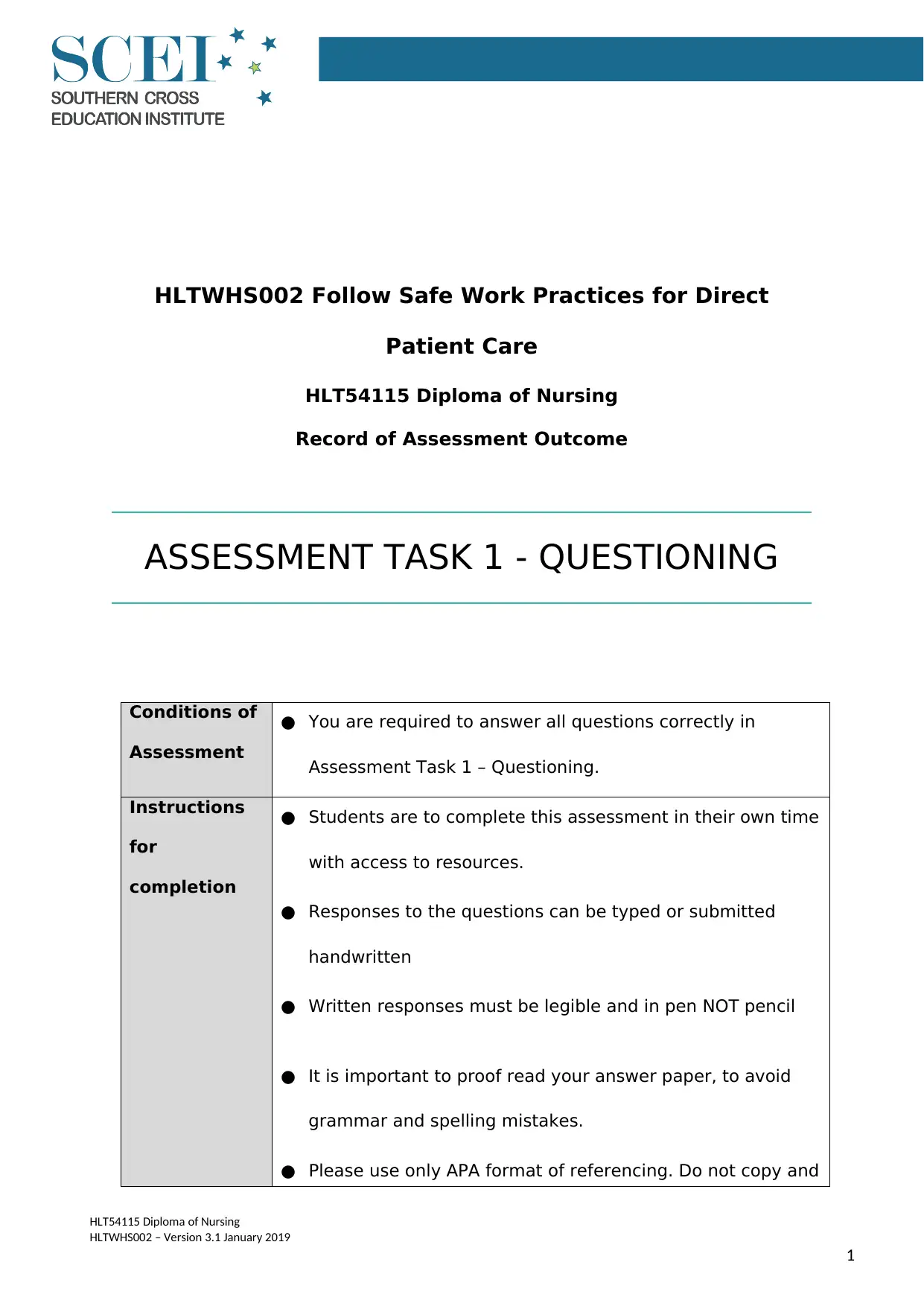
Student Assessment
HLTWHS002 Follow Safe Work Practices for Direct
Patient Care
HLT54115 Diploma of Nursing
Record of Assessment Outcome
ASSESSMENT TASK 1 - QUESTIONING
Conditions of
Assessment
● You are required to answer all questions correctly in
Assessment Task 1 – Questioning.
Instructions
for
completion
● Students are to complete this assessment in their own time
with access to resources.
● Responses to the questions can be typed or submitted
handwritten
● Written responses must be legible and in pen NOT pencil
● It is important to proof read your answer paper, to avoid
grammar and spelling mistakes.
● Please use only APA format of referencing. Do not copy and
HLT54115 Diploma of Nursing
HLTWHS002 – Version 3.1 January 2019
1
HLTWHS002 Follow Safe Work Practices for Direct
Patient Care
HLT54115 Diploma of Nursing
Record of Assessment Outcome
ASSESSMENT TASK 1 - QUESTIONING
Conditions of
Assessment
● You are required to answer all questions correctly in
Assessment Task 1 – Questioning.
Instructions
for
completion
● Students are to complete this assessment in their own time
with access to resources.
● Responses to the questions can be typed or submitted
handwritten
● Written responses must be legible and in pen NOT pencil
● It is important to proof read your answer paper, to avoid
grammar and spelling mistakes.
● Please use only APA format of referencing. Do not copy and
HLT54115 Diploma of Nursing
HLTWHS002 – Version 3.1 January 2019
1
Paraphrase This Document
Need a fresh take? Get an instant paraphrase of this document with our AI Paraphraser
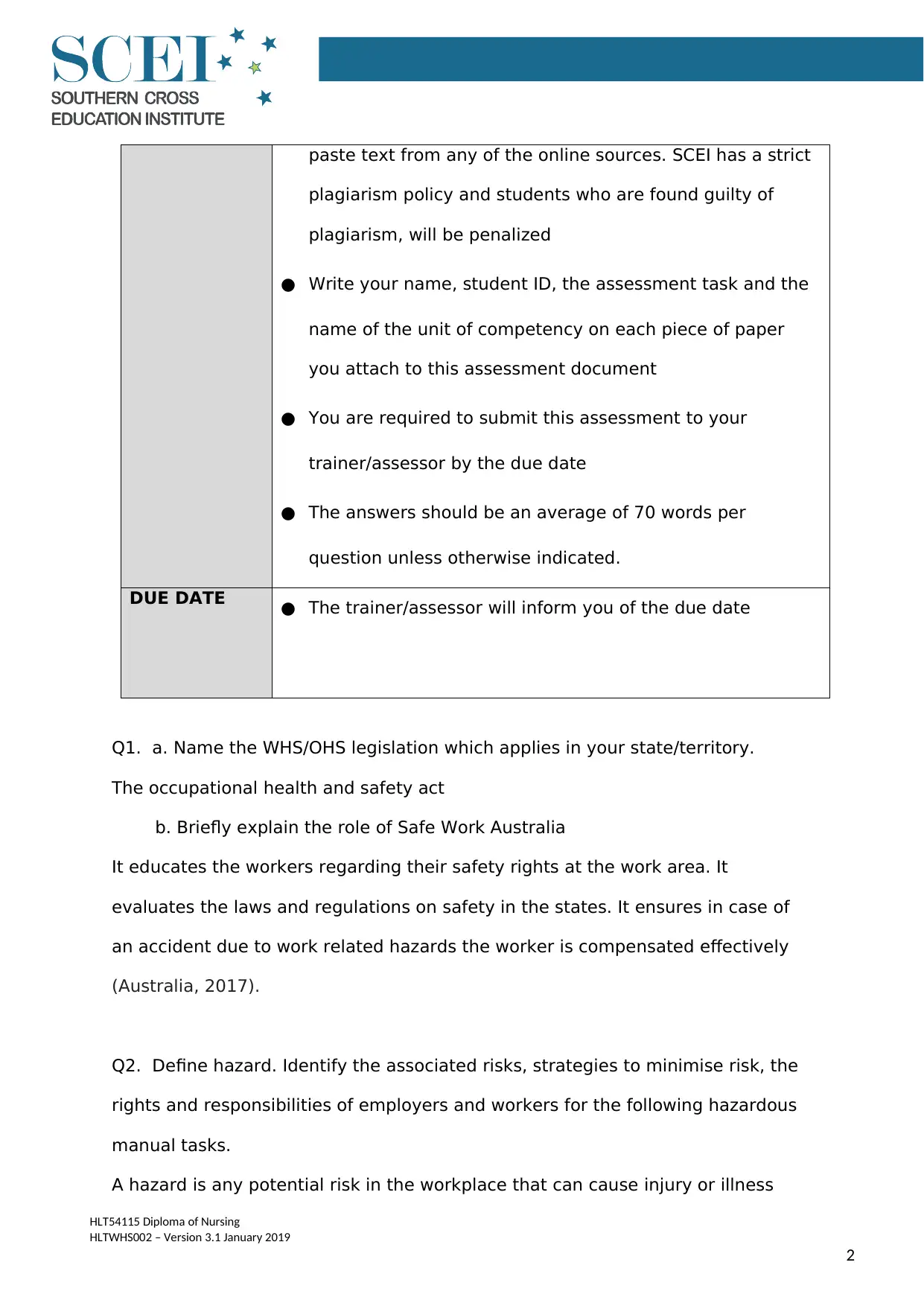
Student Assessment
paste text from any of the online sources. SCEI has a strict
plagiarism policy and students who are found guilty of
plagiarism, will be penalized
● Write your name, student ID, the assessment task and the
name of the unit of competency on each piece of paper
you attach to this assessment document
● You are required to submit this assessment to your
trainer/assessor by the due date
● The answers should be an average of 70 words per
question unless otherwise indicated.
DUE DATE ● The trainer/assessor will inform you of the due date
Q1. a. Name the WHS/OHS legislation which applies in your state/territory.
The occupational health and safety act
b. Briefly explain the role of Safe Work Australia
It educates the workers regarding their safety rights at the work area. It
evaluates the laws and regulations on safety in the states. It ensures in case of
an accident due to work related hazards the worker is compensated effectively
(Australia, 2017).
Q2. Define hazard. Identify the associated risks, strategies to minimise risk, the
rights and responsibilities of employers and workers for the following hazardous
manual tasks.
A hazard is any potential risk in the workplace that can cause injury or illness
HLT54115 Diploma of Nursing
HLTWHS002 – Version 3.1 January 2019
2
paste text from any of the online sources. SCEI has a strict
plagiarism policy and students who are found guilty of
plagiarism, will be penalized
● Write your name, student ID, the assessment task and the
name of the unit of competency on each piece of paper
you attach to this assessment document
● You are required to submit this assessment to your
trainer/assessor by the due date
● The answers should be an average of 70 words per
question unless otherwise indicated.
DUE DATE ● The trainer/assessor will inform you of the due date
Q1. a. Name the WHS/OHS legislation which applies in your state/territory.
The occupational health and safety act
b. Briefly explain the role of Safe Work Australia
It educates the workers regarding their safety rights at the work area. It
evaluates the laws and regulations on safety in the states. It ensures in case of
an accident due to work related hazards the worker is compensated effectively
(Australia, 2017).
Q2. Define hazard. Identify the associated risks, strategies to minimise risk, the
rights and responsibilities of employers and workers for the following hazardous
manual tasks.
A hazard is any potential risk in the workplace that can cause injury or illness
HLT54115 Diploma of Nursing
HLTWHS002 – Version 3.1 January 2019
2
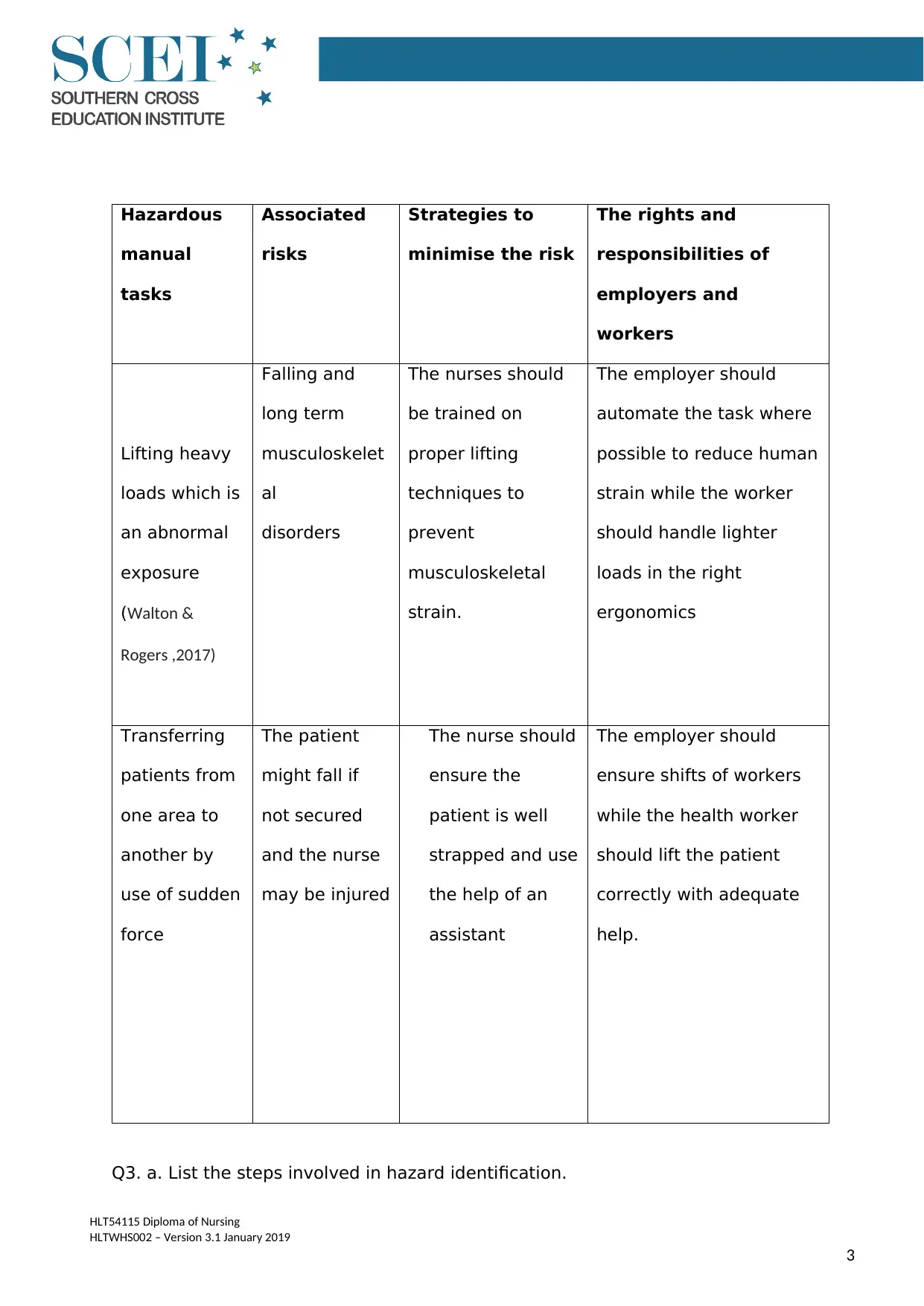
Student Assessment
Hazardous
manual
tasks
Associated
risks
Strategies to
minimise the risk
The rights and
responsibilities of
employers and
workers
Lifting heavy
loads which is
an abnormal
exposure
(Walton &
Rogers ,2017)
Falling and
long term
musculoskelet
al
disorders
The nurses should
be trained on
proper lifting
techniques to
prevent
musculoskeletal
strain.
The employer should
automate the task where
possible to reduce human
strain while the worker
should handle lighter
loads in the right
ergonomics
Transferring
patients from
one area to
another by
use of sudden
force
The patient
might fall if
not secured
and the nurse
may be injured
The nurse should
ensure the
patient is well
strapped and use
the help of an
assistant
The employer should
ensure shifts of workers
while the health worker
should lift the patient
correctly with adequate
help.
Q3. a. List the steps involved in hazard identification.
HLT54115 Diploma of Nursing
HLTWHS002 – Version 3.1 January 2019
3
Hazardous
manual
tasks
Associated
risks
Strategies to
minimise the risk
The rights and
responsibilities of
employers and
workers
Lifting heavy
loads which is
an abnormal
exposure
(Walton &
Rogers ,2017)
Falling and
long term
musculoskelet
al
disorders
The nurses should
be trained on
proper lifting
techniques to
prevent
musculoskeletal
strain.
The employer should
automate the task where
possible to reduce human
strain while the worker
should handle lighter
loads in the right
ergonomics
Transferring
patients from
one area to
another by
use of sudden
force
The patient
might fall if
not secured
and the nurse
may be injured
The nurse should
ensure the
patient is well
strapped and use
the help of an
assistant
The employer should
ensure shifts of workers
while the health worker
should lift the patient
correctly with adequate
help.
Q3. a. List the steps involved in hazard identification.
HLT54115 Diploma of Nursing
HLTWHS002 – Version 3.1 January 2019
3
⊘ This is a preview!⊘
Do you want full access?
Subscribe today to unlock all pages.

Trusted by 1+ million students worldwide
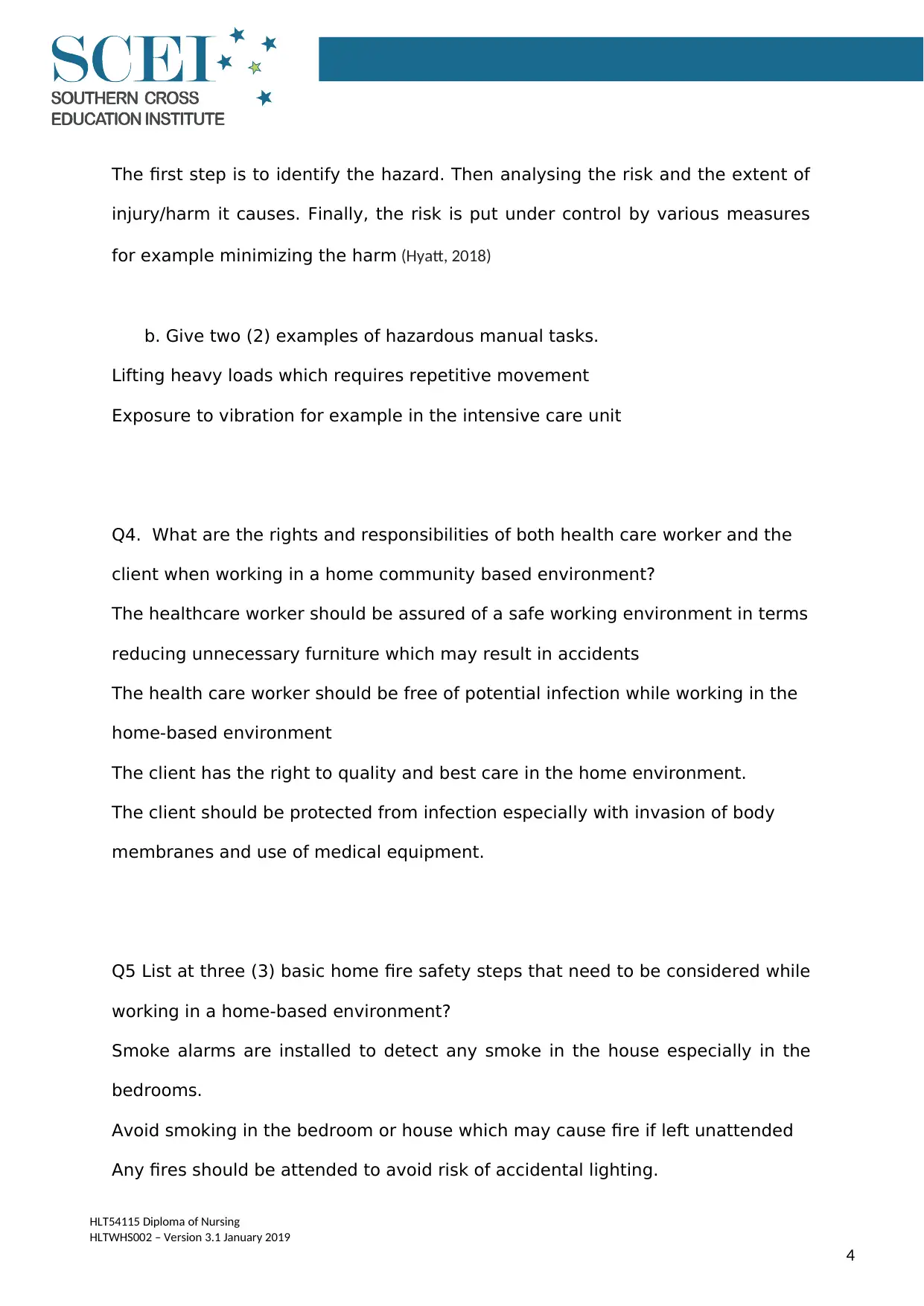
Student Assessment
The first step is to identify the hazard. Then analysing the risk and the extent of
injury/harm it causes. Finally, the risk is put under control by various measures
for example minimizing the harm (Hyatt, 2018)
b. Give two (2) examples of hazardous manual tasks.
Lifting heavy loads which requires repetitive movement
Exposure to vibration for example in the intensive care unit
Q4. What are the rights and responsibilities of both health care worker and the
client when working in a home community based environment?
The healthcare worker should be assured of a safe working environment in terms
reducing unnecessary furniture which may result in accidents
The health care worker should be free of potential infection while working in the
home-based environment
The client has the right to quality and best care in the home environment.
The client should be protected from infection especially with invasion of body
membranes and use of medical equipment.
Q5 List at three (3) basic home fire safety steps that need to be considered while
working in a home-based environment?
Smoke alarms are installed to detect any smoke in the house especially in the
bedrooms.
Avoid smoking in the bedroom or house which may cause fire if left unattended
Any fires should be attended to avoid risk of accidental lighting.
HLT54115 Diploma of Nursing
HLTWHS002 – Version 3.1 January 2019
4
The first step is to identify the hazard. Then analysing the risk and the extent of
injury/harm it causes. Finally, the risk is put under control by various measures
for example minimizing the harm (Hyatt, 2018)
b. Give two (2) examples of hazardous manual tasks.
Lifting heavy loads which requires repetitive movement
Exposure to vibration for example in the intensive care unit
Q4. What are the rights and responsibilities of both health care worker and the
client when working in a home community based environment?
The healthcare worker should be assured of a safe working environment in terms
reducing unnecessary furniture which may result in accidents
The health care worker should be free of potential infection while working in the
home-based environment
The client has the right to quality and best care in the home environment.
The client should be protected from infection especially with invasion of body
membranes and use of medical equipment.
Q5 List at three (3) basic home fire safety steps that need to be considered while
working in a home-based environment?
Smoke alarms are installed to detect any smoke in the house especially in the
bedrooms.
Avoid smoking in the bedroom or house which may cause fire if left unattended
Any fires should be attended to avoid risk of accidental lighting.
HLT54115 Diploma of Nursing
HLTWHS002 – Version 3.1 January 2019
4
Paraphrase This Document
Need a fresh take? Get an instant paraphrase of this document with our AI Paraphraser
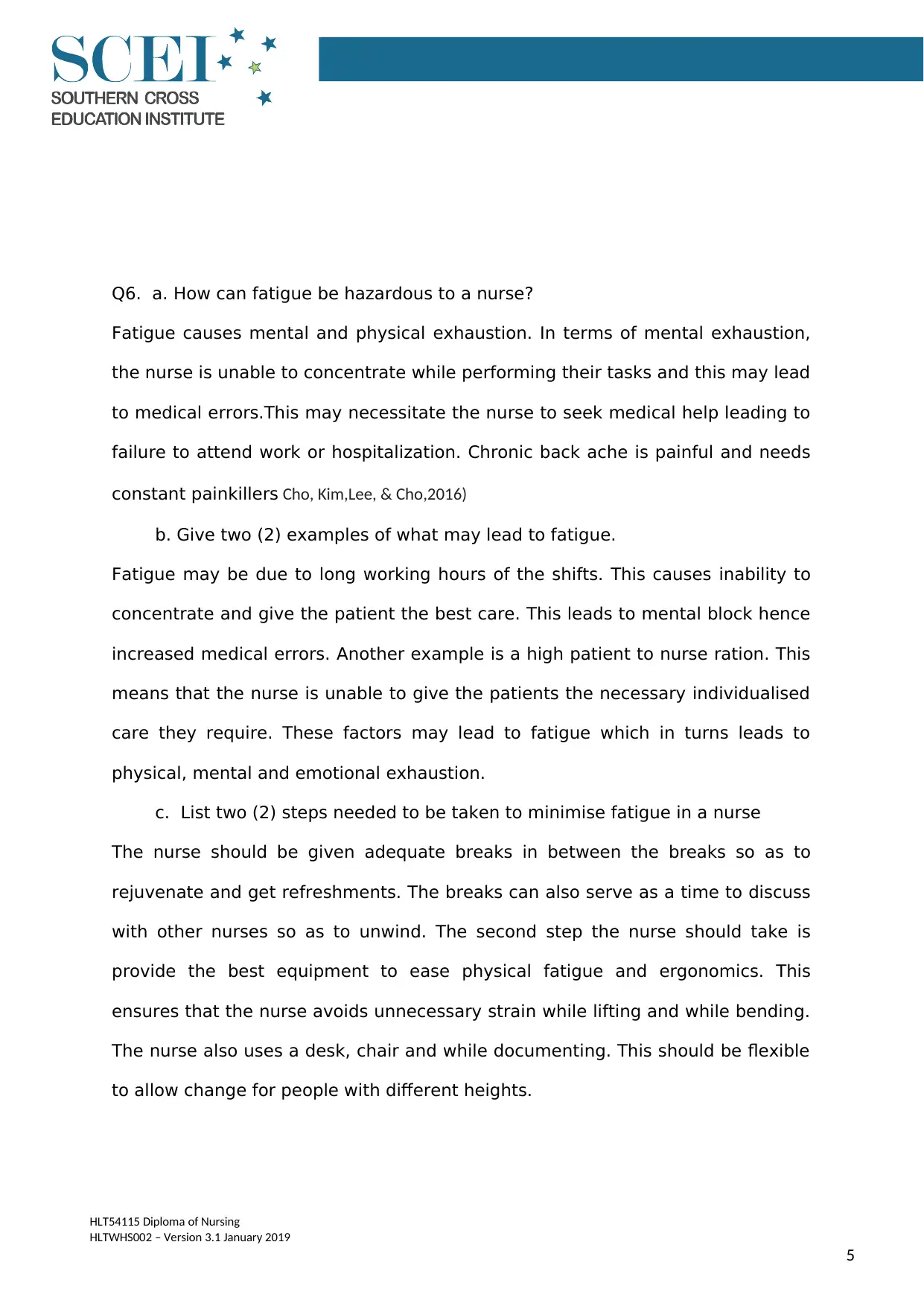
Student Assessment
Q6. a. How can fatigue be hazardous to a nurse?
Fatigue causes mental and physical exhaustion. In terms of mental exhaustion,
the nurse is unable to concentrate while performing their tasks and this may lead
to medical errors.This may necessitate the nurse to seek medical help leading to
failure to attend work or hospitalization. Chronic back ache is painful and needs
constant painkillers Cho, Kim,Lee, & Cho,2016)
b. Give two (2) examples of what may lead to fatigue.
Fatigue may be due to long working hours of the shifts. This causes inability to
concentrate and give the patient the best care. This leads to mental block hence
increased medical errors. Another example is a high patient to nurse ration. This
means that the nurse is unable to give the patients the necessary individualised
care they require. These factors may lead to fatigue which in turns leads to
physical, mental and emotional exhaustion.
c. List two (2) steps needed to be taken to minimise fatigue in a nurse
The nurse should be given adequate breaks in between the breaks so as to
rejuvenate and get refreshments. The breaks can also serve as a time to discuss
with other nurses so as to unwind. The second step the nurse should take is
provide the best equipment to ease physical fatigue and ergonomics. This
ensures that the nurse avoids unnecessary strain while lifting and while bending.
The nurse also uses a desk, chair and while documenting. This should be flexible
to allow change for people with different heights.
HLT54115 Diploma of Nursing
HLTWHS002 – Version 3.1 January 2019
5
Q6. a. How can fatigue be hazardous to a nurse?
Fatigue causes mental and physical exhaustion. In terms of mental exhaustion,
the nurse is unable to concentrate while performing their tasks and this may lead
to medical errors.This may necessitate the nurse to seek medical help leading to
failure to attend work or hospitalization. Chronic back ache is painful and needs
constant painkillers Cho, Kim,Lee, & Cho,2016)
b. Give two (2) examples of what may lead to fatigue.
Fatigue may be due to long working hours of the shifts. This causes inability to
concentrate and give the patient the best care. This leads to mental block hence
increased medical errors. Another example is a high patient to nurse ration. This
means that the nurse is unable to give the patients the necessary individualised
care they require. These factors may lead to fatigue which in turns leads to
physical, mental and emotional exhaustion.
c. List two (2) steps needed to be taken to minimise fatigue in a nurse
The nurse should be given adequate breaks in between the breaks so as to
rejuvenate and get refreshments. The breaks can also serve as a time to discuss
with other nurses so as to unwind. The second step the nurse should take is
provide the best equipment to ease physical fatigue and ergonomics. This
ensures that the nurse avoids unnecessary strain while lifting and while bending.
The nurse also uses a desk, chair and while documenting. This should be flexible
to allow change for people with different heights.
HLT54115 Diploma of Nursing
HLTWHS002 – Version 3.1 January 2019
5
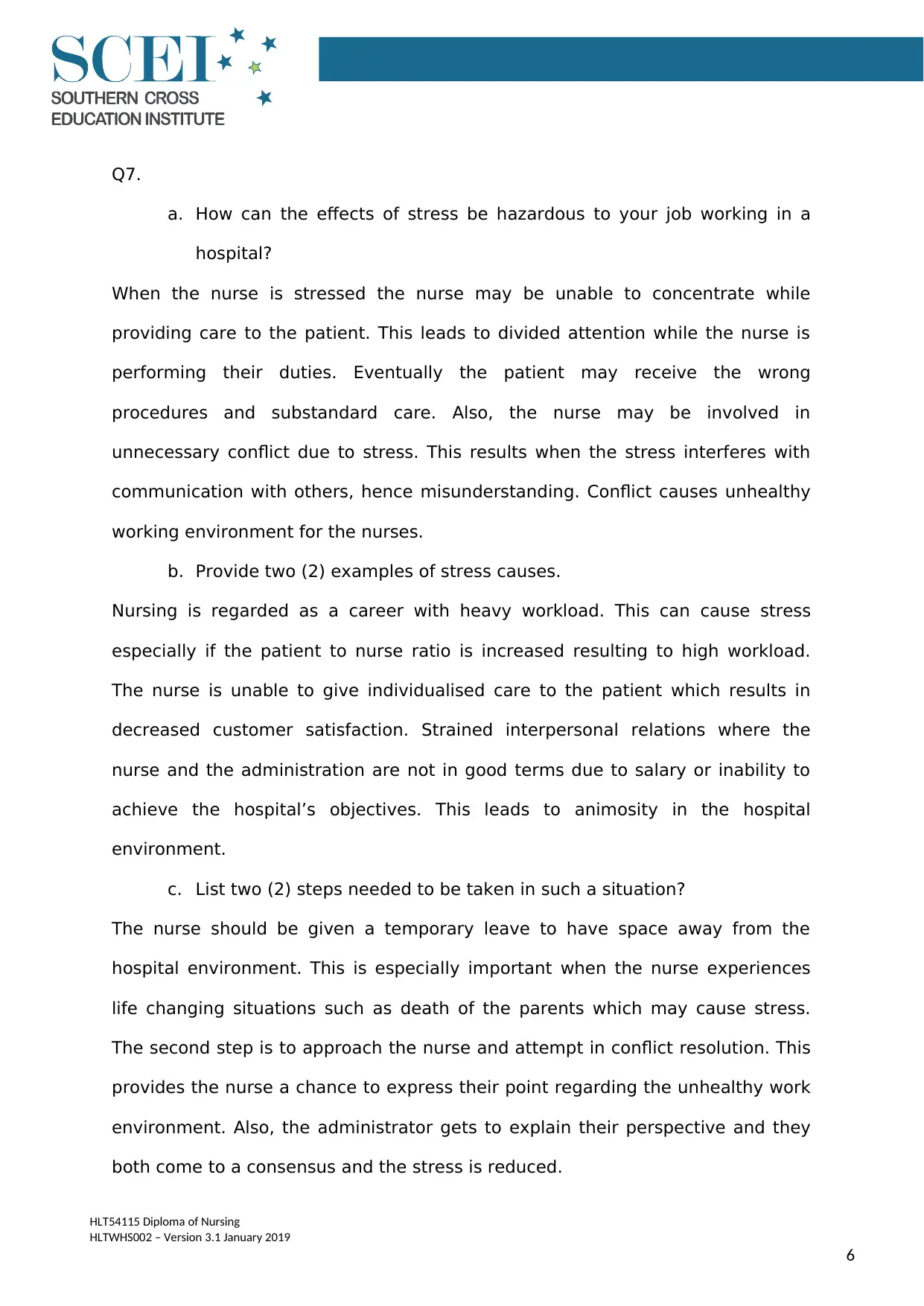
Student Assessment
Q7.
a. How can the effects of stress be hazardous to your job working in a
hospital?
When the nurse is stressed the nurse may be unable to concentrate while
providing care to the patient. This leads to divided attention while the nurse is
performing their duties. Eventually the patient may receive the wrong
procedures and substandard care. Also, the nurse may be involved in
unnecessary conflict due to stress. This results when the stress interferes with
communication with others, hence misunderstanding. Conflict causes unhealthy
working environment for the nurses.
b. Provide two (2) examples of stress causes.
Nursing is regarded as a career with heavy workload. This can cause stress
especially if the patient to nurse ratio is increased resulting to high workload.
The nurse is unable to give individualised care to the patient which results in
decreased customer satisfaction. Strained interpersonal relations where the
nurse and the administration are not in good terms due to salary or inability to
achieve the hospital’s objectives. This leads to animosity in the hospital
environment.
c. List two (2) steps needed to be taken in such a situation?
The nurse should be given a temporary leave to have space away from the
hospital environment. This is especially important when the nurse experiences
life changing situations such as death of the parents which may cause stress.
The second step is to approach the nurse and attempt in conflict resolution. This
provides the nurse a chance to express their point regarding the unhealthy work
environment. Also, the administrator gets to explain their perspective and they
both come to a consensus and the stress is reduced.
HLT54115 Diploma of Nursing
HLTWHS002 – Version 3.1 January 2019
6
Q7.
a. How can the effects of stress be hazardous to your job working in a
hospital?
When the nurse is stressed the nurse may be unable to concentrate while
providing care to the patient. This leads to divided attention while the nurse is
performing their duties. Eventually the patient may receive the wrong
procedures and substandard care. Also, the nurse may be involved in
unnecessary conflict due to stress. This results when the stress interferes with
communication with others, hence misunderstanding. Conflict causes unhealthy
working environment for the nurses.
b. Provide two (2) examples of stress causes.
Nursing is regarded as a career with heavy workload. This can cause stress
especially if the patient to nurse ratio is increased resulting to high workload.
The nurse is unable to give individualised care to the patient which results in
decreased customer satisfaction. Strained interpersonal relations where the
nurse and the administration are not in good terms due to salary or inability to
achieve the hospital’s objectives. This leads to animosity in the hospital
environment.
c. List two (2) steps needed to be taken in such a situation?
The nurse should be given a temporary leave to have space away from the
hospital environment. This is especially important when the nurse experiences
life changing situations such as death of the parents which may cause stress.
The second step is to approach the nurse and attempt in conflict resolution. This
provides the nurse a chance to express their point regarding the unhealthy work
environment. Also, the administrator gets to explain their perspective and they
both come to a consensus and the stress is reduced.
HLT54115 Diploma of Nursing
HLTWHS002 – Version 3.1 January 2019
6
⊘ This is a preview!⊘
Do you want full access?
Subscribe today to unlock all pages.

Trusted by 1+ million students worldwide
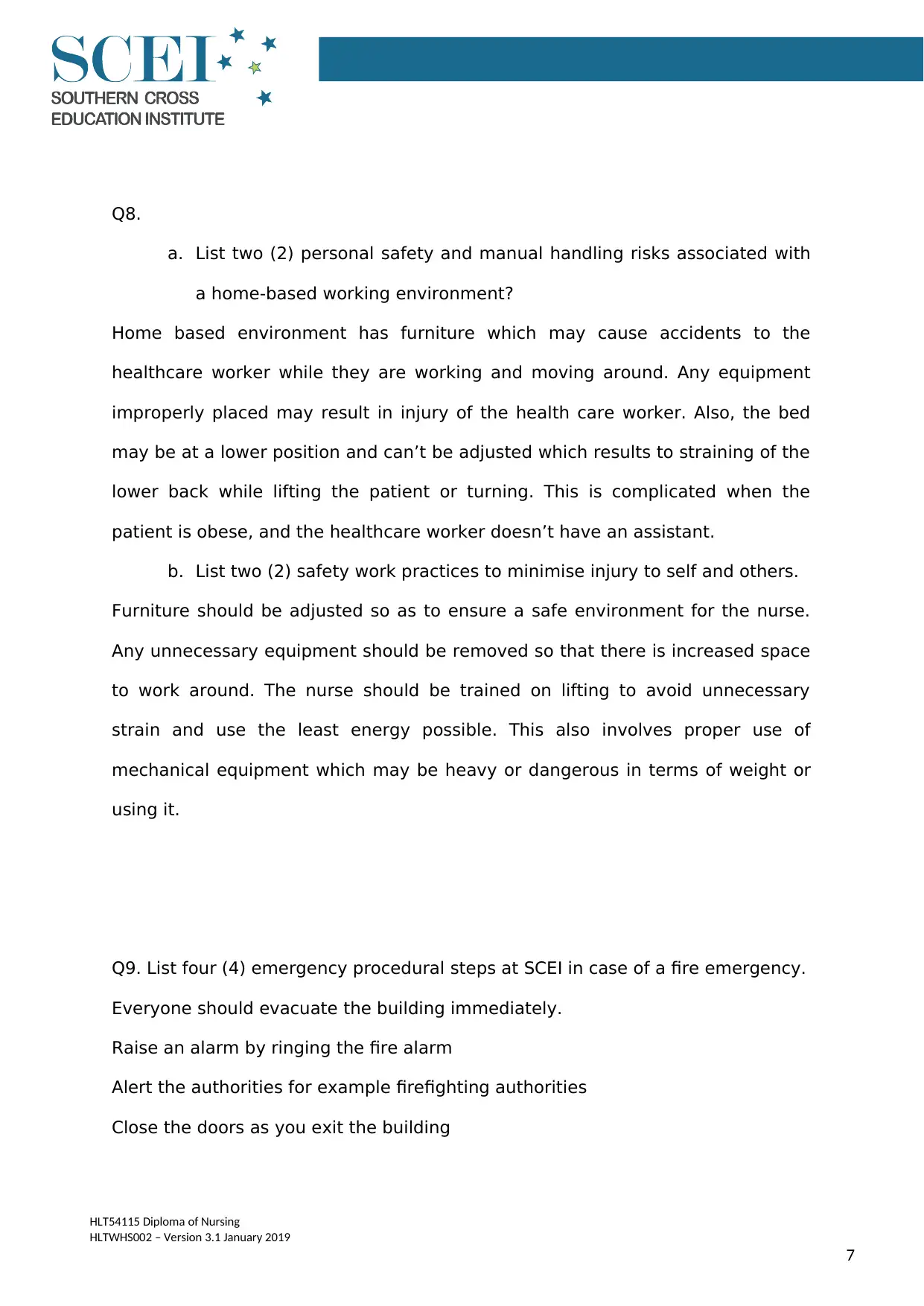
Student Assessment
Q8.
a. List two (2) personal safety and manual handling risks associated with
a home-based working environment?
Home based environment has furniture which may cause accidents to the
healthcare worker while they are working and moving around. Any equipment
improperly placed may result in injury of the health care worker. Also, the bed
may be at a lower position and can’t be adjusted which results to straining of the
lower back while lifting the patient or turning. This is complicated when the
patient is obese, and the healthcare worker doesn’t have an assistant.
b. List two (2) safety work practices to minimise injury to self and others.
Furniture should be adjusted so as to ensure a safe environment for the nurse.
Any unnecessary equipment should be removed so that there is increased space
to work around. The nurse should be trained on lifting to avoid unnecessary
strain and use the least energy possible. This also involves proper use of
mechanical equipment which may be heavy or dangerous in terms of weight or
using it.
Q9. List four (4) emergency procedural steps at SCEI in case of a fire emergency.
Everyone should evacuate the building immediately.
Raise an alarm by ringing the fire alarm
Alert the authorities for example firefighting authorities
Close the doors as you exit the building
HLT54115 Diploma of Nursing
HLTWHS002 – Version 3.1 January 2019
7
Q8.
a. List two (2) personal safety and manual handling risks associated with
a home-based working environment?
Home based environment has furniture which may cause accidents to the
healthcare worker while they are working and moving around. Any equipment
improperly placed may result in injury of the health care worker. Also, the bed
may be at a lower position and can’t be adjusted which results to straining of the
lower back while lifting the patient or turning. This is complicated when the
patient is obese, and the healthcare worker doesn’t have an assistant.
b. List two (2) safety work practices to minimise injury to self and others.
Furniture should be adjusted so as to ensure a safe environment for the nurse.
Any unnecessary equipment should be removed so that there is increased space
to work around. The nurse should be trained on lifting to avoid unnecessary
strain and use the least energy possible. This also involves proper use of
mechanical equipment which may be heavy or dangerous in terms of weight or
using it.
Q9. List four (4) emergency procedural steps at SCEI in case of a fire emergency.
Everyone should evacuate the building immediately.
Raise an alarm by ringing the fire alarm
Alert the authorities for example firefighting authorities
Close the doors as you exit the building
HLT54115 Diploma of Nursing
HLTWHS002 – Version 3.1 January 2019
7
Paraphrase This Document
Need a fresh take? Get an instant paraphrase of this document with our AI Paraphraser
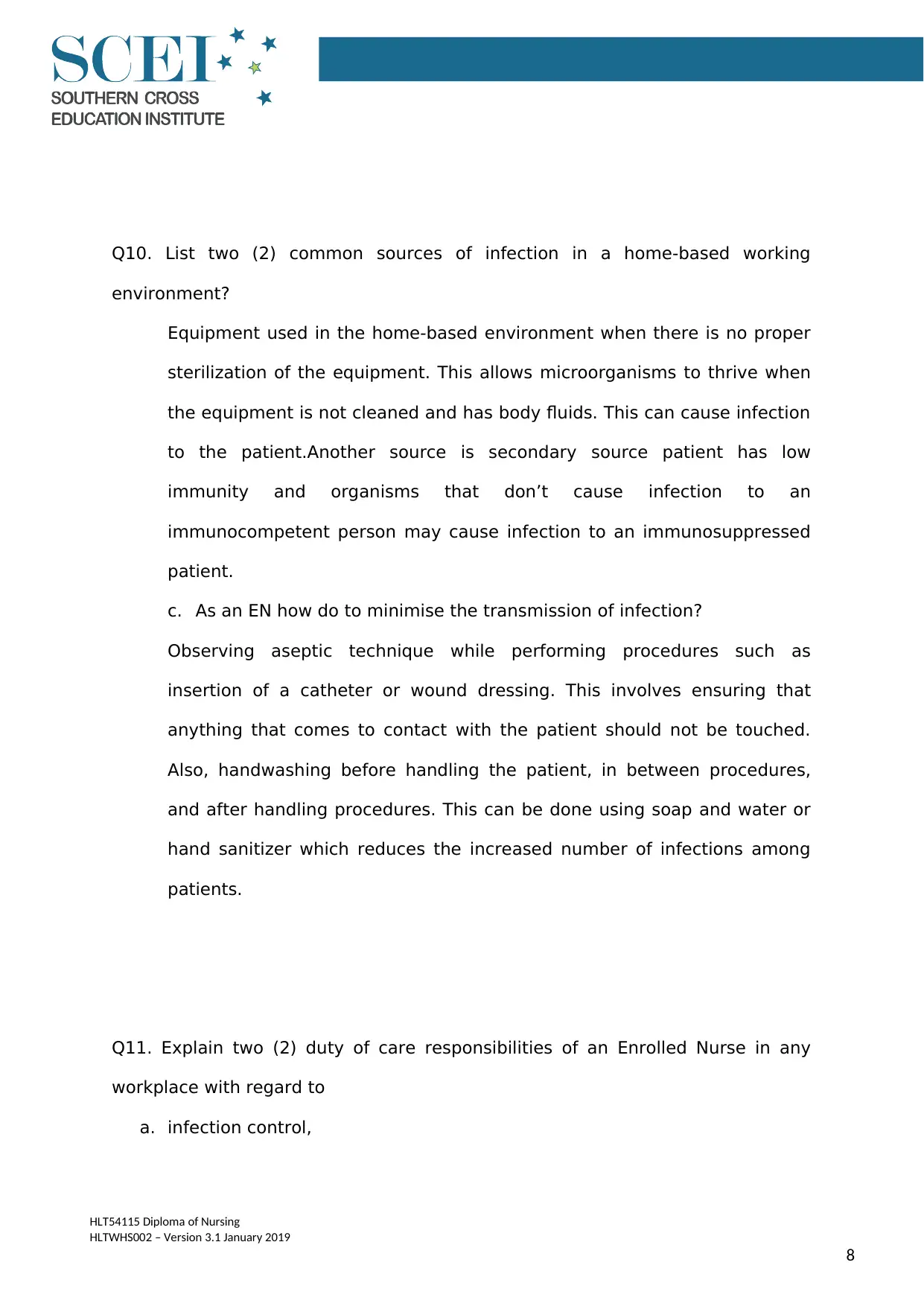
Student Assessment
Q10. List two (2) common sources of infection in a home-based working
environment?
Equipment used in the home-based environment when there is no proper
sterilization of the equipment. This allows microorganisms to thrive when
the equipment is not cleaned and has body fluids. This can cause infection
to the patient.Another source is secondary source patient has low
immunity and organisms that don’t cause infection to an
immunocompetent person may cause infection to an immunosuppressed
patient.
c. As an EN how do to minimise the transmission of infection?
Observing aseptic technique while performing procedures such as
insertion of a catheter or wound dressing. This involves ensuring that
anything that comes to contact with the patient should not be touched.
Also, handwashing before handling the patient, in between procedures,
and after handling procedures. This can be done using soap and water or
hand sanitizer which reduces the increased number of infections among
patients.
Q11. Explain two (2) duty of care responsibilities of an Enrolled Nurse in any
workplace with regard to
a. infection control,
HLT54115 Diploma of Nursing
HLTWHS002 – Version 3.1 January 2019
8
Q10. List two (2) common sources of infection in a home-based working
environment?
Equipment used in the home-based environment when there is no proper
sterilization of the equipment. This allows microorganisms to thrive when
the equipment is not cleaned and has body fluids. This can cause infection
to the patient.Another source is secondary source patient has low
immunity and organisms that don’t cause infection to an
immunocompetent person may cause infection to an immunosuppressed
patient.
c. As an EN how do to minimise the transmission of infection?
Observing aseptic technique while performing procedures such as
insertion of a catheter or wound dressing. This involves ensuring that
anything that comes to contact with the patient should not be touched.
Also, handwashing before handling the patient, in between procedures,
and after handling procedures. This can be done using soap and water or
hand sanitizer which reduces the increased number of infections among
patients.
Q11. Explain two (2) duty of care responsibilities of an Enrolled Nurse in any
workplace with regard to
a. infection control,
HLT54115 Diploma of Nursing
HLTWHS002 – Version 3.1 January 2019
8
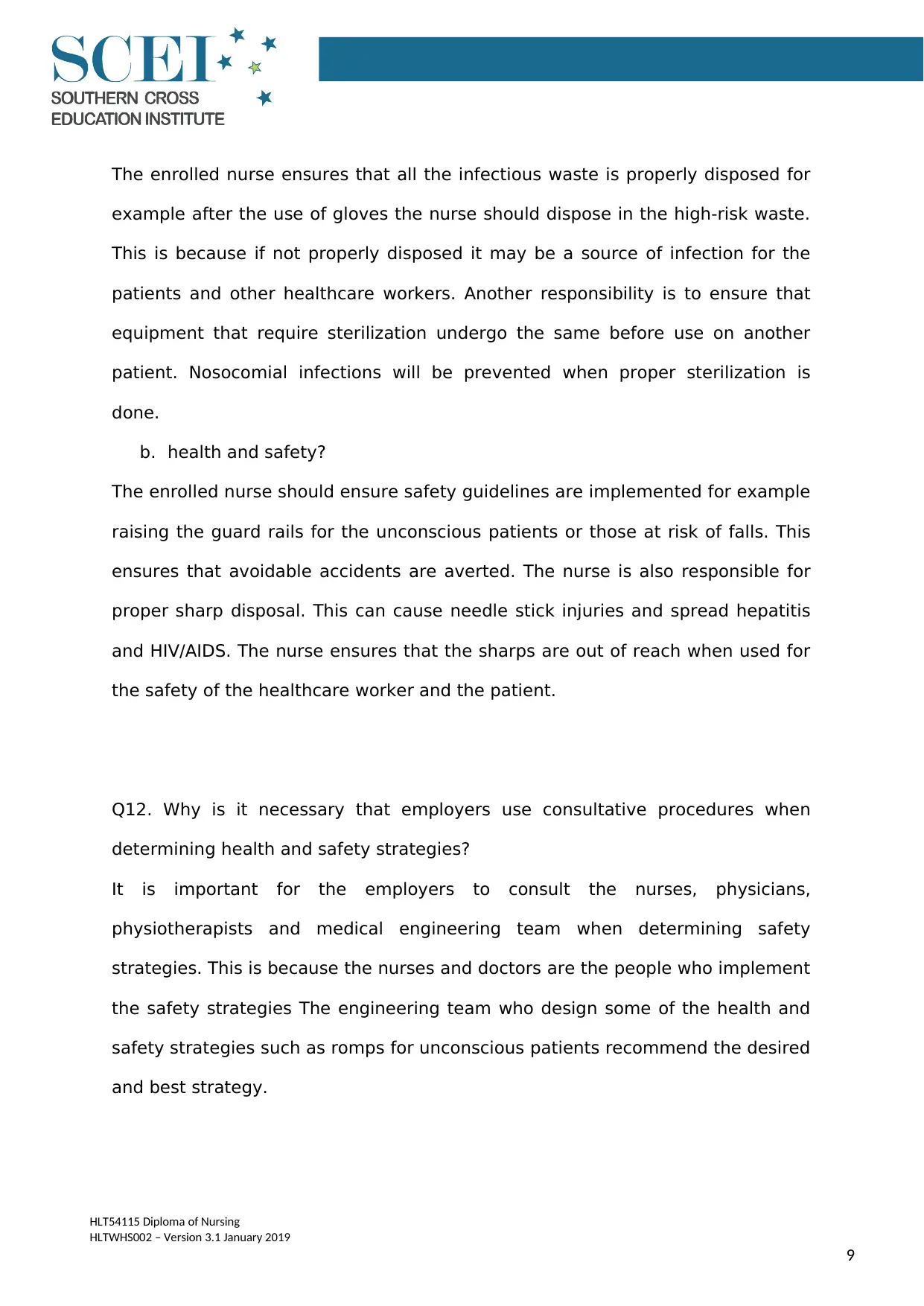
Student Assessment
The enrolled nurse ensures that all the infectious waste is properly disposed for
example after the use of gloves the nurse should dispose in the high-risk waste.
This is because if not properly disposed it may be a source of infection for the
patients and other healthcare workers. Another responsibility is to ensure that
equipment that require sterilization undergo the same before use on another
patient. Nosocomial infections will be prevented when proper sterilization is
done.
b. health and safety?
The enrolled nurse should ensure safety guidelines are implemented for example
raising the guard rails for the unconscious patients or those at risk of falls. This
ensures that avoidable accidents are averted. The nurse is also responsible for
proper sharp disposal. This can cause needle stick injuries and spread hepatitis
and HIV/AIDS. The nurse ensures that the sharps are out of reach when used for
the safety of the healthcare worker and the patient.
Q12. Why is it necessary that employers use consultative procedures when
determining health and safety strategies?
It is important for the employers to consult the nurses, physicians,
physiotherapists and medical engineering team when determining safety
strategies. This is because the nurses and doctors are the people who implement
the safety strategies The engineering team who design some of the health and
safety strategies such as romps for unconscious patients recommend the desired
and best strategy.
HLT54115 Diploma of Nursing
HLTWHS002 – Version 3.1 January 2019
9
The enrolled nurse ensures that all the infectious waste is properly disposed for
example after the use of gloves the nurse should dispose in the high-risk waste.
This is because if not properly disposed it may be a source of infection for the
patients and other healthcare workers. Another responsibility is to ensure that
equipment that require sterilization undergo the same before use on another
patient. Nosocomial infections will be prevented when proper sterilization is
done.
b. health and safety?
The enrolled nurse should ensure safety guidelines are implemented for example
raising the guard rails for the unconscious patients or those at risk of falls. This
ensures that avoidable accidents are averted. The nurse is also responsible for
proper sharp disposal. This can cause needle stick injuries and spread hepatitis
and HIV/AIDS. The nurse ensures that the sharps are out of reach when used for
the safety of the healthcare worker and the patient.
Q12. Why is it necessary that employers use consultative procedures when
determining health and safety strategies?
It is important for the employers to consult the nurses, physicians,
physiotherapists and medical engineering team when determining safety
strategies. This is because the nurses and doctors are the people who implement
the safety strategies The engineering team who design some of the health and
safety strategies such as romps for unconscious patients recommend the desired
and best strategy.
HLT54115 Diploma of Nursing
HLTWHS002 – Version 3.1 January 2019
9
⊘ This is a preview!⊘
Do you want full access?
Subscribe today to unlock all pages.

Trusted by 1+ million students worldwide
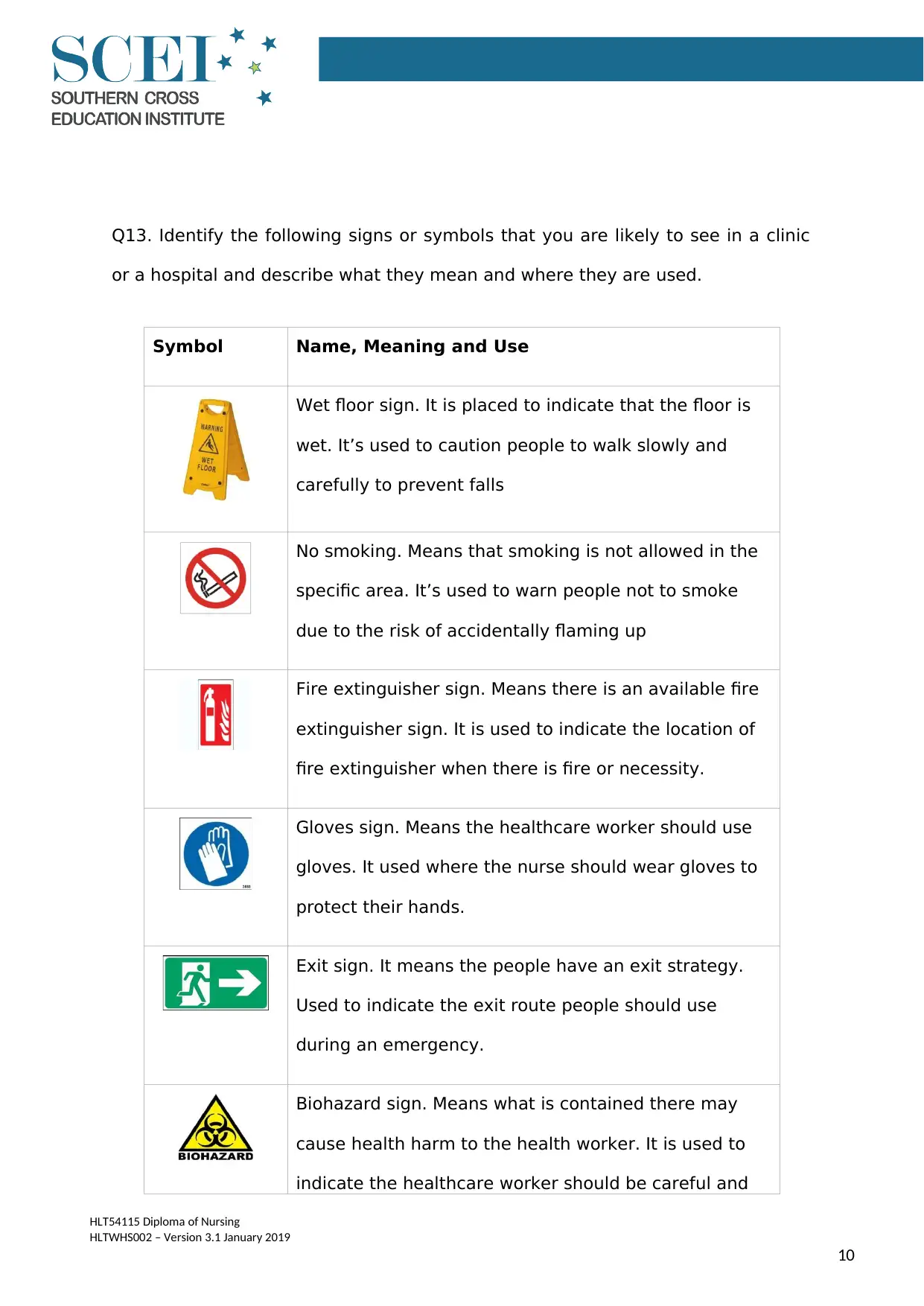
Student Assessment
Q13. Identify the following signs or symbols that you are likely to see in a clinic
or a hospital and describe what they mean and where they are used.
Symbol Name, Meaning and Use
Wet floor sign. It is placed to indicate that the floor is
wet. It’s used to caution people to walk slowly and
carefully to prevent falls
No smoking. Means that smoking is not allowed in the
specific area. It’s used to warn people not to smoke
due to the risk of accidentally flaming up
Fire extinguisher sign. Means there is an available fire
extinguisher sign. It is used to indicate the location of
fire extinguisher when there is fire or necessity.
Gloves sign. Means the healthcare worker should use
gloves. It used where the nurse should wear gloves to
protect their hands.
Exit sign. It means the people have an exit strategy.
Used to indicate the exit route people should use
during an emergency.
Biohazard sign. Means what is contained there may
cause health harm to the health worker. It is used to
indicate the healthcare worker should be careful and
HLT54115 Diploma of Nursing
HLTWHS002 – Version 3.1 January 2019
10
Q13. Identify the following signs or symbols that you are likely to see in a clinic
or a hospital and describe what they mean and where they are used.
Symbol Name, Meaning and Use
Wet floor sign. It is placed to indicate that the floor is
wet. It’s used to caution people to walk slowly and
carefully to prevent falls
No smoking. Means that smoking is not allowed in the
specific area. It’s used to warn people not to smoke
due to the risk of accidentally flaming up
Fire extinguisher sign. Means there is an available fire
extinguisher sign. It is used to indicate the location of
fire extinguisher when there is fire or necessity.
Gloves sign. Means the healthcare worker should use
gloves. It used where the nurse should wear gloves to
protect their hands.
Exit sign. It means the people have an exit strategy.
Used to indicate the exit route people should use
during an emergency.
Biohazard sign. Means what is contained there may
cause health harm to the health worker. It is used to
indicate the healthcare worker should be careful and
HLT54115 Diploma of Nursing
HLTWHS002 – Version 3.1 January 2019
10
Paraphrase This Document
Need a fresh take? Get an instant paraphrase of this document with our AI Paraphraser
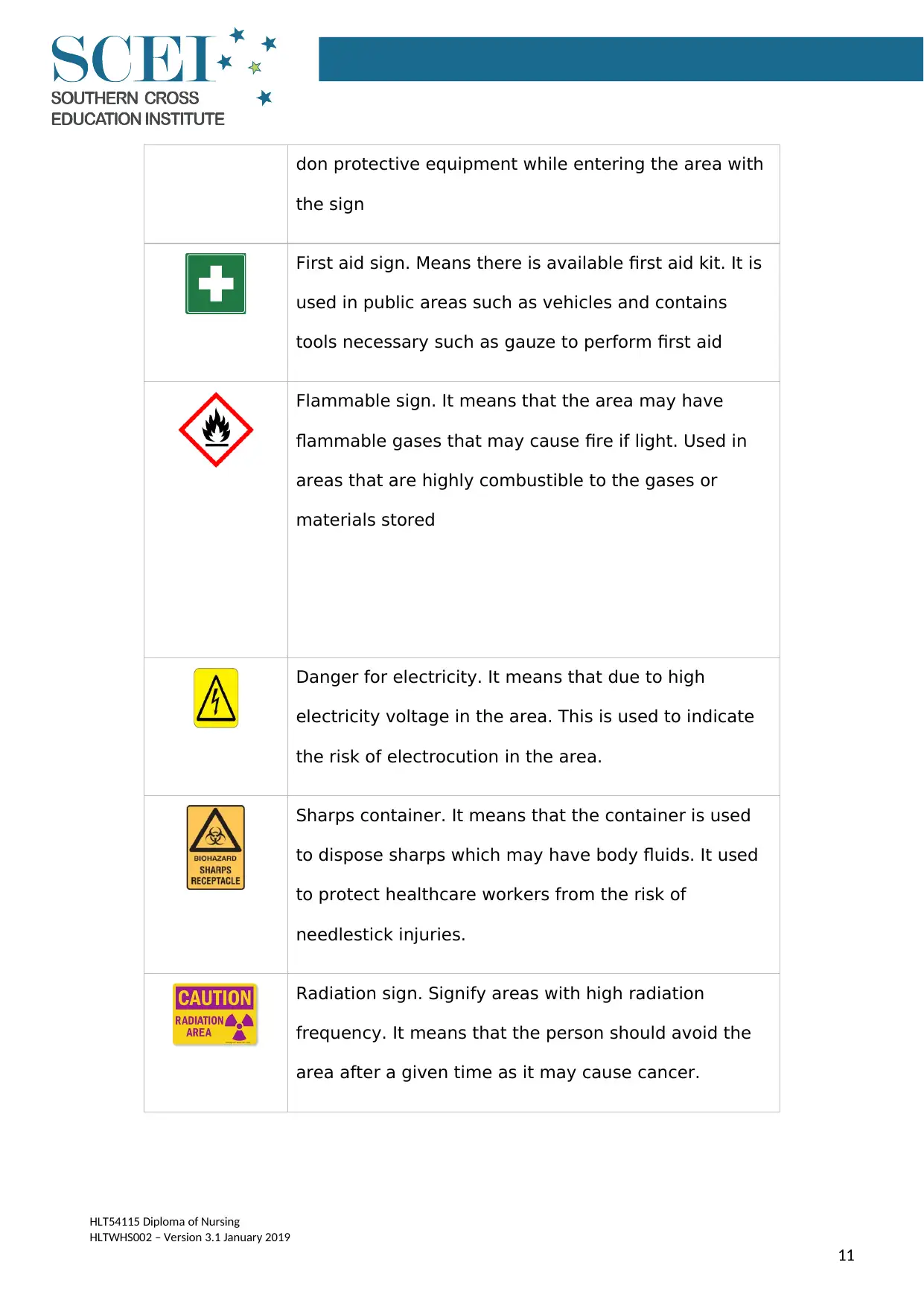
Student Assessment
don protective equipment while entering the area with
the sign
First aid sign. Means there is available first aid kit. It is
used in public areas such as vehicles and contains
tools necessary such as gauze to perform first aid
Flammable sign. It means that the area may have
flammable gases that may cause fire if light. Used in
areas that are highly combustible to the gases or
materials stored
Danger for electricity. It means that due to high
electricity voltage in the area. This is used to indicate
the risk of electrocution in the area.
Sharps container. It means that the container is used
to dispose sharps which may have body fluids. It used
to protect healthcare workers from the risk of
needlestick injuries.
Radiation sign. Signify areas with high radiation
frequency. It means that the person should avoid the
area after a given time as it may cause cancer.
HLT54115 Diploma of Nursing
HLTWHS002 – Version 3.1 January 2019
11
don protective equipment while entering the area with
the sign
First aid sign. Means there is available first aid kit. It is
used in public areas such as vehicles and contains
tools necessary such as gauze to perform first aid
Flammable sign. It means that the area may have
flammable gases that may cause fire if light. Used in
areas that are highly combustible to the gases or
materials stored
Danger for electricity. It means that due to high
electricity voltage in the area. This is used to indicate
the risk of electrocution in the area.
Sharps container. It means that the container is used
to dispose sharps which may have body fluids. It used
to protect healthcare workers from the risk of
needlestick injuries.
Radiation sign. Signify areas with high radiation
frequency. It means that the person should avoid the
area after a given time as it may cause cancer.
HLT54115 Diploma of Nursing
HLTWHS002 – Version 3.1 January 2019
11
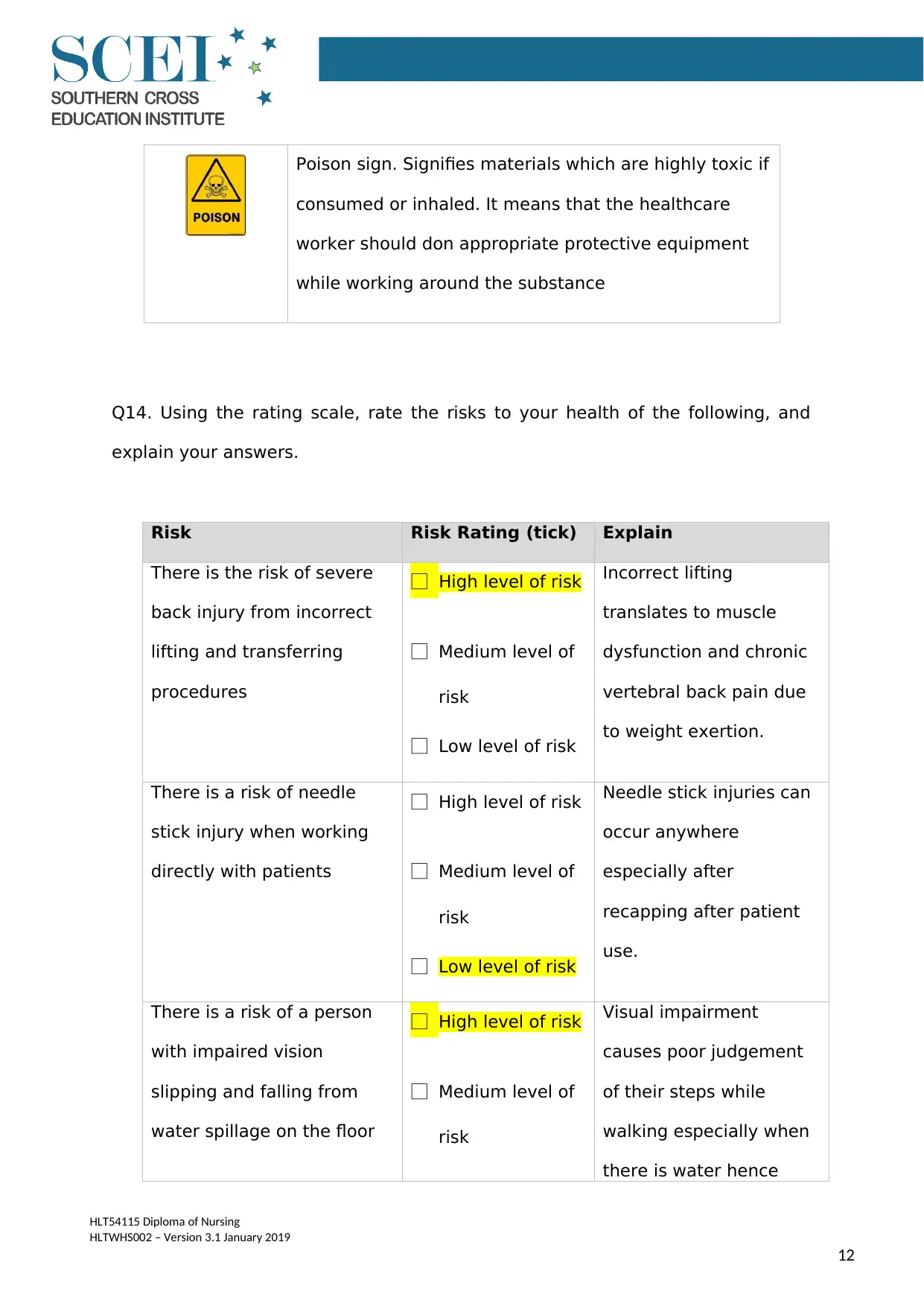
Student Assessment
Poison sign. Signifies materials which are highly toxic if
consumed or inhaled. It means that the healthcare
worker should don appropriate protective equipment
while working around the substance
Q14. Using the rating scale, rate the risks to your health of the following, and
explain your answers.
Risk Risk Rating (tick) Explain
There is the risk of severe
back injury from incorrect
lifting and transferring
procedures
⬜ High level of risk
⬜ Medium level of
risk
⬜ Low level of risk
Incorrect lifting
translates to muscle
dysfunction and chronic
vertebral back pain due
to weight exertion.
There is a risk of needle
stick injury when working
directly with patients
⬜ High level of risk
⬜ Medium level of
risk
⬜ Low level of risk
Needle stick injuries can
occur anywhere
especially after
recapping after patient
use.
There is a risk of a person
with impaired vision
slipping and falling from
water spillage on the floor
⬜ High level of risk
⬜ Medium level of
risk
Visual impairment
causes poor judgement
of their steps while
walking especially when
there is water hence
HLT54115 Diploma of Nursing
HLTWHS002 – Version 3.1 January 2019
12
Poison sign. Signifies materials which are highly toxic if
consumed or inhaled. It means that the healthcare
worker should don appropriate protective equipment
while working around the substance
Q14. Using the rating scale, rate the risks to your health of the following, and
explain your answers.
Risk Risk Rating (tick) Explain
There is the risk of severe
back injury from incorrect
lifting and transferring
procedures
⬜ High level of risk
⬜ Medium level of
risk
⬜ Low level of risk
Incorrect lifting
translates to muscle
dysfunction and chronic
vertebral back pain due
to weight exertion.
There is a risk of needle
stick injury when working
directly with patients
⬜ High level of risk
⬜ Medium level of
risk
⬜ Low level of risk
Needle stick injuries can
occur anywhere
especially after
recapping after patient
use.
There is a risk of a person
with impaired vision
slipping and falling from
water spillage on the floor
⬜ High level of risk
⬜ Medium level of
risk
Visual impairment
causes poor judgement
of their steps while
walking especially when
there is water hence
HLT54115 Diploma of Nursing
HLTWHS002 – Version 3.1 January 2019
12
⊘ This is a preview!⊘
Do you want full access?
Subscribe today to unlock all pages.

Trusted by 1+ million students worldwide
1 out of 23
Related Documents
Your All-in-One AI-Powered Toolkit for Academic Success.
+13062052269
info@desklib.com
Available 24*7 on WhatsApp / Email
![[object Object]](/_next/static/media/star-bottom.7253800d.svg)
Unlock your academic potential
Copyright © 2020–2025 A2Z Services. All Rights Reserved. Developed and managed by ZUCOL.





